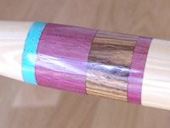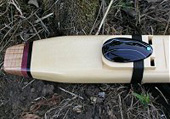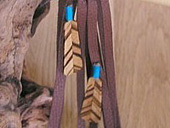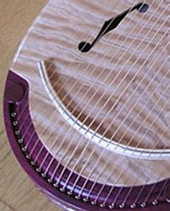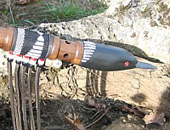| Frequently Asked Questions |
My journey with the Native American Flute has been long and eventful! Apart from creating these wonderful instruments I have also had the pleasure of passing on my knowledge to many flute players and flute makers at Universities, Institutions, flute venues, correspondence and over the World Wide Web. Over the many years I have been asked many questions about flute making and playing and to this very day I continue to be fascinated by the quality of the questions asked. Fortunately, I have studied the playing and creating aspects of the Native American Flute since I discovered it in the 1970s which enables me to answer most, if not all, questions that are asked of me. On this page of my web site I will endeavor to list all those questions that are most frequently asked. Bore Sizes Question: How relevant is the bore size to the key (scale) the flute is being created to play? Answer: Bore sizes are critical! Take for example an F# flute. This tuning requires a fundamental note of F#4 up to at least the highest note of its basic or primary note of G5. Whereas a 7/8th inch bore will basically suit the fundamental F#4 a more appropriate bore size for the G5 is 3/4 of an inch. In this instance a bore size needs to be used that will accommodate both the F#4 and the G5 perfectly. In order to do this the flute maker needs to calculate a bore size that will accommodate both the F#4 and the G5 as well as higher notes that can be played by a quality 1.4 octave flute. In such an instance a realistic bore size will be between 7/8ths (.875) of an inch and 3/4 (.750) of an inch. A bore size of .8043 is calculated to be the most suitable. Creating a flute with an accurate bore size of .8043 requires the flute body to be created in two halves so that the routed bore can be accurately established. No drill manufacturing company creates a standard .8043 drill bit so creating a flute in two halves is an important aspect of a quality instrument. The reason why such a bore size of .8043 should be used for an F# flute is very simple. 'Recorder' makers, for example, understand the principals of relevant bore sizes and use a conical bore for accuracy. This allows the lowest note, that is formed in the larger part of the conical bore, to form correctly right up to the highest notes that form in the smallest part of the conical bore. The Native American Flute does not have a conical bore and so an acceptable bore size needs to be calculated so that the lowest and highest notes all play accurately. This is often more/less than a standard drill bit size. Over sizing a bore can produce many problems with a flute when it is played. 'Drop out' is a classic example when, during playing a tune, the flute stops playing and then recovers again. This is due to the 'node' (that is formed inside the flute when it is played) not being able to establish itself correctly because the bore is too large. This often explains why 'Mega Bore' flutes do not play too well and are often 'noisy' due to excessive 'white noise'. Fingering Hole Sizes Question: The fingering holes on my flute are all different sizes. Is this correct or should they all be the same size? Answer: Fingering hole sizes depend on what the flute maker's intension's were when the flute was created. Many flutes can be created with fingering holes that are all the same size whereas some will be easier to finger if different fingering hole sizes are utilized so that they are brought closer together. Flutes that are intentionally created in these ways are fine! However, if fingering hole sizes differ because of instrument tuning, problems will occur. Whenever a flute is created there are maximum and minimum fingering hole sizes that must NOT be exceeded, not only for correct tuning of the primary scale but also for decent sounding primary and cross-fingered notes. If a flute maker has a problem tuning a particular fingering hole and he/she increases the hole beyond the maximum hole size, the flute will neither play well nor tune correctly. The only way to keep within the minimum/maximum fingering hole sizes is to correctly calculate the precise placement of the holes themselves so that hacking away at fingering holes, in order to force the hole into tune, is not at all necessary. Similarly, a very small fingering hole amidst others that are larger can also create problems. If a flute maker is not aware of maximum and minimum fingering hole sizes and creates a flute with such a hole that is smaller than the minimum hole size, then that note will play badly and, quite often, very noticeably quieter than the other notes of the flute. Note: It is worth mentioning that the maximum and minimum fingering hole sizes will, amongst other things, depend on the bore size and 'key' of the flute being created. Breaking into the Upper Octave Question: Why does the top fingering hole note (highest note of the primary scale) break into the upper octave if I blow just a little too hard? Answer: In order to answer this question, one has to understand a little about how a flute works when it is played. Although this is quite a complex study I will endeavor to explain it in a simple way. Most flute folks have heard of the 'K2' that forms at the True Sound Hole (embouchure) and it is this that, along with another aspect, that causes the flute to jump into the upper octave. What happens when a flute is played (in its lowest or basic octave) is that a single 'node' forms inside the flute. This node is created by Mother Nature. At either side of the node there is an anti-node which is also formed by Mother Nature. If the anti-node that has formed between the bridge and the node enters the K2 pressure of the flute, the node will double itself up which forces the note being played to jump into the upper octave. Unfortunately, there is no way to correct this scenario as the fingering holes have been incorrectly placed, often due to the sound chamber being too short. Length to Bore Ratios Question: I am new to flute making and have read somewhere on the internet that the ideal length to bore ratio is 18:1. Am I correct in assuming that if I use a 1 inch bore, the sound chamber will be 18 inches in length? Answer: Sadly, you are not correct! The ratio of 18:1 is an acceptable value BUT this value is only a part of the whole equation. The value of the K2 (formed at the embouchure or TSH) and the length of the K1 (formed at the foot of the flute) have to be taken into consideration when arriving at the best length to bore ratio. Doing such a calculation arrives at an ideal length to bore ratio of 24:1. However, this does not mean you should create a flute with a 1 inch bore to be 24 inches in length. Both the K1 and the K2 form only when the flute is played so the physical flute body of the sound chamber will be shorter. For example, a flute with 1 inch bore, in the key of C, will be between 21 and 22 inches in length depending on the size of the TSH/embouchure the flute maker intends to create. It is complicated but this is something all flute makers should know and understand if they are to create quality instruments! Airy Sounding Flutes Question: Some of the flutes I own (Not any of yours though!) have an airy/breathy sound when they are played. Why is this and can it be corrected? Answer: There are a few reasons why a flute will sound airy or breathy when it is played but the most common one is due to an inappropriate size and/or shape of the True Sound Hole (embouchure). No matter how gently you blow into a flute there is a huge amount of air that passes over the TSH/embouchure and into the sound chamber that the instrument does not require. So, if you consider that Mother nature only requires a single, horizontal layer of air molecules to hit a cutting edge in order to create a note, the remainder of the air She does not need will pass over and into the instrument. The amount of air that is required to make the notes we want to hear is just a very minute fraction of the air being blown into the flute. Although this surplus air does not hit the cutting edge of the TSH/embouchure to form a note it will make a noise. This noise is known as 'White Noise'. White noise can be reduced by creating a TSH/embouchure to a specific length from the bridge towards the foot of the flute. If the length is too great, too much surplus air is drawn into the instrument which is amplified by the sound chamber. This is the 'airy/breathy' noise that you hear. Another, and equally important, way to reduce white noise is to ensure the cutting edge (the edge the air hits to produce a note) is sharp and not blunt. A blunt cutting edge will also create white noise and this occurs when the air that creates the note also bounces from the blunt cutting edge back towards the bridge and back again to the cutting edge. The pressure of this 'bouncing' air will not be sufficient to play a note but the instrument will amplify it as white noise. Unfortunately, there is no fix or cure for an airy/breathy flute other then to have major surgery done to the instrument so that a correct TSH/embouchure can be created. (See also 'Placement of the Block/Fetish') Placement of the Block/Fetish Question: I have been told, and have read in many flute tutorials, that the Block should be placed up against the back edge of the True Sound Hole. However, a few flute makers state that their Block should be placed a fraction back from the TSH. Can you explain why this is? Answer: This is one of the most problematic scenarios in the Native American Flute world. There have been many occasions, especially at flute venues, when I have witnessed a flute player adjust a block so that it was sited up against the back edge of the True Sound Hole only to find the flute did not play too well. When the flute maker informed them that the Block should be placed slightly back from the TSH, they have replaced the flute on the seller's table because they think the flute has not been correctly made. They could NOT be more WRONG! The uncertainty of where to place a block basically arises from ignorance! As much as I hate to state this fact, it is true. Facilitators of Native American Flute institutions, Native American Flute 'advice' websites and flute teachers all give liberal advice on the subject of Block placement and flute making but I have yet to encounter one who actually understands the 'physics' involved in creating this instrument. As a result of this 'ignorance' their advice is often poor or totally incorrect. Creating a quality Native American Flute is a precise science because the playability and tuning of the flute is all governed by Mother Nature. Many times I have been condemned for using math and physics to create my flutes because it is assumed that Native American Flutes should never be created in this way as it is unnatural. Well, I can assure them that creating an instrument that allows Mother nature to do all the things She does when a flute is played IS quite natural! So, block placement will depend on how a flute is created. Using my flutes as an example, I will create it measuring and calculating the correct bore size for maximum playability, the containment (for precise fingering hole placement), the K1 (for correct flute length), the K2 (for correct embouchure sizing), wall thickness (also for fingering hole placement/tuning) and BREATH PRESSURE. I create my instruments using what I call The Breath of Life System which I developed many years ago. What this does is to allow the flute player to play the instrument with just the minimum amount of breath pressure. Needless to say, this has many, many advantages! The sum of all this determines where the block needs to be placed because not only does the flute need to play with little breath pressure, it needs to respond if a flute player blows harder into it. Being able to do this evolves around that little column of air that flows between the base of the Block and the TSH when the flute is played. When a TSH/embouchure is precisely calculated and created the length of it (from the bridge towards the foot) will be less than the air pressure needed to make it play notes. As a result of this, mathematically/physically, the block needs to be back from the TSH just a fraction (between 2 & 3 64ths of one inch). This placement is both correct and TOTALLY natural. So, my advice to you is to check with the flute maker where the block needs to be or experiment by finding the place where the flute plays at its best. Please do not expect the block to be up against the TSH and please ignore advise given by those who are not qualified to give it. Playing Upper Octave Notes Question: How is it that by covering certain fingering holes I can make my flute play in the upper octave? Answer: When a flute is played, air passes down the length of the sound chamber and Mother Nature responds by pushing air back up the sound chamber. This might be considered as Her way of keeping everything in 'balance'! Somewhere around the middle of the sound chamber, the column of air you are creating when you blow meets the column of air Mother Nature is pushing back at you. The point where the two columns of air meet creates a point where nothing is moving either up nor down the sound chamber. This point is known at a musical 'node'. The sum of these columns of air is known as the containment. When all the fingering holes of a flute are covered (playing the fundamental note of the instrument) the node will settle midway in the sound chamber. When the first fingering hole is lifted the containment shortens slightly and so the node moves up the sound chamber, creating a higher note. Lifting a certain finger off a certain (or series of) fingering hole(s) will force the node to form close to the area of the bridge (where TSH/embouchure is) and this creates sufficient pressure within the flute to break the node into two. It is another natural occurrence courtesy of Mother Nature. Having two nodes basically creates pressures that are found in flutes created in the higher or upper octave so the flute will respond by playing notes in the same way. |


